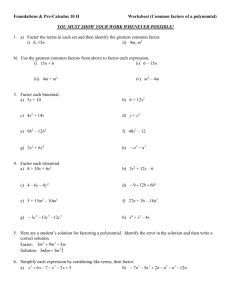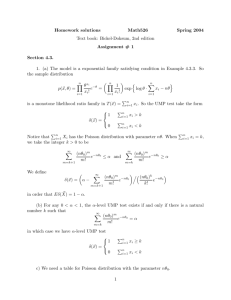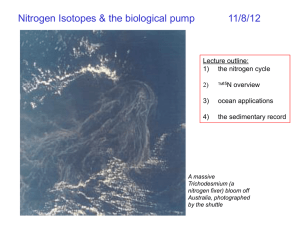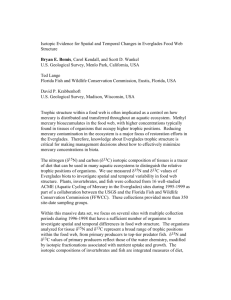Document 10833095
advertisement
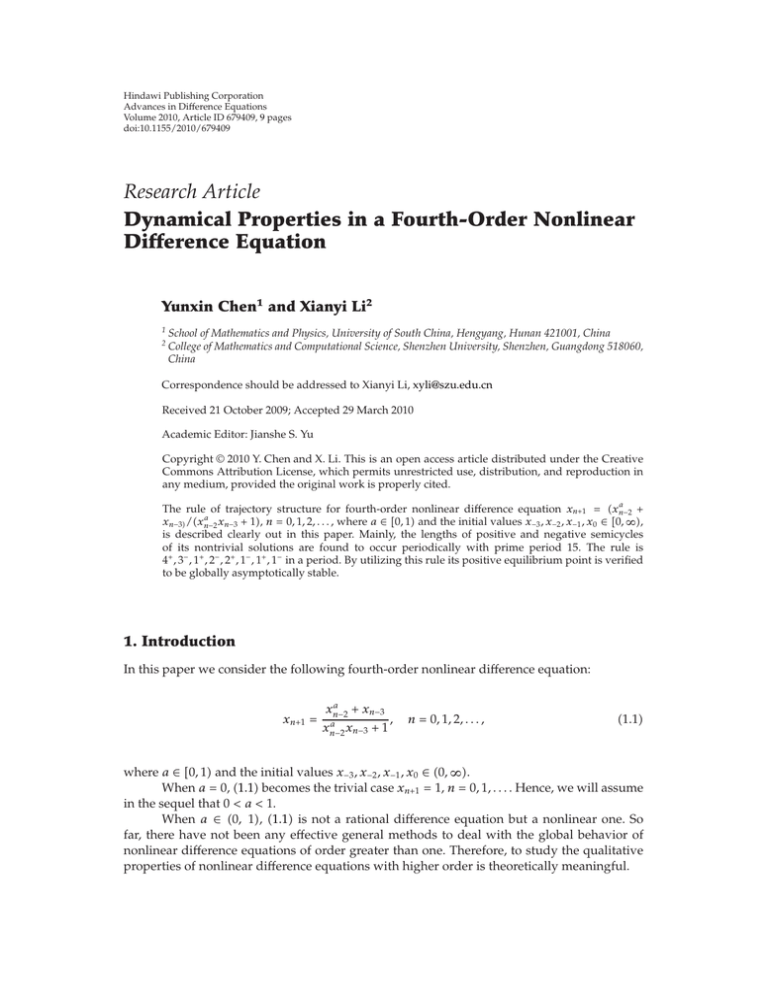
Hindawi Publishing Corporation
Advances in Difference Equations
Volume 2010, Article ID 679409, 9 pages
doi:10.1155/2010/679409
Research Article
Dynamical Properties in a Fourth-Order Nonlinear
Difference Equation
Yunxin Chen1 and Xianyi Li2
1
2
School of Mathematics and Physics, University of South China, Hengyang, Hunan 421001, China
College of Mathematics and Computational Science, Shenzhen University, Shenzhen, Guangdong 518060,
China
Correspondence should be addressed to Xianyi Li, xyli@szu.edu.cn
Received 21 October 2009; Accepted 29 March 2010
Academic Editor: Jianshe S. Yu
Copyright q 2010 Y. Chen and X. Li. This is an open access article distributed under the Creative
Commons Attribution License, which permits unrestricted use, distribution, and reproduction in
any medium, provided the original work is properly cited.
The rule of trajectory structure for fourth-order nonlinear difference equation xn1 xan−2 xn−3 /xan−2 xn−3 1, n 0, 1, 2, . . . , where a ∈ 0, 1 and the initial values x−3 , x−2 , x−1 , x0 ∈ 0, ∞,
is described clearly out in this paper. Mainly, the lengths of positive and negative semicycles
of its nontrivial solutions are found to occur periodically with prime period 15. The rule is
4 , 3− , 1 , 2− , 2 , 1− , 1 , 1− in a period. By utilizing this rule its positive equilibrium point is verified
to be globally asymptotically stable.
1. Introduction
In this paper we consider the following fourth-order nonlinear difference equation:
xn1 a
xn−3
xn−2
,
a
xn−2 xn−3 1
n 0, 1, 2, . . . ,
1.1
where a ∈ 0, 1 and the initial values x−3 , x−2 , x−1 , x0 ∈ 0, ∞.
When a 0, 1.1 becomes the trivial case xn1 1, n 0, 1, . . . . Hence, we will assume
in the sequel that 0 < a < 1.
When a ∈ 0, 1, 1.1 is not a rational difference equation but a nonlinear one. So
far, there have not been any effective general methods to deal with the global behavior of
nonlinear difference equations of order greater than one. Therefore, to study the qualitative
properties of nonlinear difference equations with higher order is theoretically meaningful.
2
Advances in Difference Equations
In this paper, it is of key for us to find that the lengths of positive and negative semicycles of nontrivial solutions of 1.1 occur periodically with prime period 15 with the rule
4 , 3− , 1 , 2− , 2 , 1− , 1 , 1− and in a period. With the help of this rule and utilizing the
monotonicity of solution the positive equilibrium point of the equation is verified to be
globally asymptotically stable.
Essentially, we derive the following results for solutions of 1.1.
Theorem CL. The rule of the trajectory structure of 1.1 is that all of its solutions asymptotically
approach its equilibrium; furthermore, any one of its solutions is either
1 eventually trivial
2 nonoscillatory and eventually negative (i.e., xn ≥ 1) or
3 strictly oscillatory with the lengths of positive and negative semi-cycles periodically
successively occurring with prime period 15 and the rule to be 4 , 3− , 1 , 2− , 2 , 1− , 1 , 1−
in a period.
It follows from the results stated below that Theorem CL is true.
It is easy to see that the positive equilibrium x of 1.1 satisfies
x
xa x
,
xa x 1
1.2
from which one can see that 1.1 has a unique equilibrium x 1.
In the following, we state some main definitions used in this paper.
Definition 1.1. A positive semi-cycle {xn }∞
n−3 of a solution of 1.1 consists of a “string” of
terms xl , xl1 , . . . , xm , all greater than or equal to the equilibrium x, with l ≥ −3 and m ≤ ∞
such that
either l −3 or l > −3, xl−1 < x ,
either m ∞ or m < ∞, xm1 < x.
1.3
A negative semi-cycle of a solution {xn }∞
n−3 of 1.1 consists of a “string” of term
xl , xl1 , . . . , xm , all less than x, with l ≥ −3 and m ≤ ∞ such that
either l −3 or l > −3, xl−1 ≥ x ,
either m ∞ or m < ∞, xm1 ≥ x.
1.4
The length of a semi-cycle is the number of the total terms contained in it.
Definition 1.2. A solution {xn }∞
n−3 of 1.1 is said to be eventually trivial if xn is eventually
equal to x 1; Otherwise, the solution is said to be nontrivial. A solution {xn }∞
n−3 of 1.1 is
said to be eventually positive negative if xn is eventually greater less than x 1.
For the other concepts in this paper and related work, see 1–3 and 4–11,
respectively.
Advances in Difference Equations
3
2. Three Lemmas
Before drawing a qualitatively clear picture for the solutions of 1.1, we first establish three
basic lemmas which will play key roles in the proof of our main results.
Lemma 2.1. A solution {xn }∞
n−3 of 1.1 is eventually trivial if and only if
x−3 − 1x−2 − 1x−1 − 1x0 − 1 0.
2.1
Proof. Sufficiency. Assume that 2.1 holds. Then it follows from 1.1 that the following
conclusions hold:
i if x−3 − 1 0, then xn 1 for n ≥ 7;
ii if x−2 − 1 0, then xn 1 for n ≥ 4;
iii if x−1 − 1 0, then xn 1 for n ≥ 5;
iv if x0 − 1 0, then xn 1 for n ≥ 6.
Necessity. Conversely, assume that
0.
x−3 − 1x−2 − 1x−1 − 1x0 − 1 /
2.2
Then one can show that
xn /1
for any n ≥ 1.
2.3
Assume the contrary that for some N ≥ 1,
xN 1
and that
xn /
1 for − 3 ≤ n ≤ N − 1.
2.4
Clearly,
1 xN a
xN−3
xN−4
,
a
xN−3 xN−4 1
2.5
a
which implies that xN−3
− 1xN−4 − 1 0, which contradicts 2.4.
Remark 2.2. Lemma 2.1 actually demonstrates that a solution {xn }∞
n−3 of 1.1 is eventually
nontrivial if and only if
0.
x−3 − 1x−2 − 1x−1 − 1x0 − 1 /
2.6
Therefore, if a solution {xn }∞
1 for n ≥ −3.
n−3 is nontrivial, then xn /
Lemma 2.3. Let {xn }∞
n−3 be a nontrivial positive solution of 1.1. Then the following conclusions
are true:
4
Advances in Difference Equations
a xn1 − 1xn−2 − 1xn−3 − 1 < 0 for n ≥ 0;
b xn1 − xn−3 xn−3 − 1 < 0 for n ≥ 0.
Proof. In view of 1.1, we can see that
a
− 1 xn−3 − 1
xn−2
xn1 − 1 −
,
a
xn−2
xn−3 1
xn1 − xn−3
xa 1 − xn−3 1 xn−3 ,
n−2 a
xn−2 xn−3 1
n 0, 1, . . . ,
2.7
n 0, 1, . . .
from which inequalities a and b follow. So the proof is complete.
Lemma 2.4. There exist nonoscillatory solutions of 1.1, which must be eventually negative. There
do not exist eventually positive non-oscillatory solutions of 1.1.
Proof. Consider a solution of 1.1 with x−3 < 1, x−2 < 1, x−1 < 1, and x0 < 1. We then
know from Lemma 2.3a that xn < 1 for n ≥ −3. So, this solution is just a non-oscillatory
solution, and furthermore, eventually negative. Suppose that there exist eventually positive
nonoscillatory solutions of 1.1. Then, there exists a positive integer N such that xn > 1 for
n ≥ N. Thereout, for n ≥ N 3, xn1 −1xn−2 −1xn−3 −1 > 0. This contradicts Lemma 2.3a.
So, there do not exist eventually positive non-oscillatory solutions of 1.1, as desired.
3. Main Results and Their Proofs
First we analyze the structure of the semi-cycles of nontrivial solutions of 1.1. Here we
confine us to consider the situation of the strictly oscillatory solution of 1.1.
Theorem 3.1. Let {xn }∞
n−3 be any strictly oscillatory solution of 1.1. Then, the lengths of positive
and negative semi-cycles of the solution periodically successively occur with prime period 15. And in
a period, the rule is 4 , 3− , 1 , 2− , 2 , 1− , 1 , 1− .
Proof. By Lemma 2.3a, one can see that the length of a positive semi-cycle is not larger than
4, whereas, the length of a negative semi-cycle is at most 3. Based on the strictly oscillatory
character of the solution, we see, for some integer p ≥ 0, that one of the following four cases
must occur.
Case 1. xp−3 > 1, xp−2 < 1, xp−1 > 1, xp > 1.
Case 2. xp−3 > 1, xp−2 < 1, xp−1 > 1, xp < 1.
Case 3. xp−3 > 1, xp−2 < 1, xp−1 < 1, xp > 1.
Case 4. xp−3 > 1, xp−2 < 1, xp−1 < 1, xp < 1.
If Case 1 occurs, it follows from Lemma 2.3a that xp−3 > 1, xp−2 < 1, xp−1 > 1, xp >
xp1 > 1, xp2 > 1, xp3 < 1, xp4 < 1, xp5 < 1, xp6 > 1, xp7 < 1, xp8 < 1, xp9 >
xp10 > 1, xp11 < 1, xp12 > 1, xp13 < 1, xp14 > 1, xp15 > 1, xp16 > 1, xp17 > 1, xp18 <
xp19 < 1, xp20 < 1, xp21 > 1, xp22 < 1, xp23 < 1, xp24 > 1, xp25 > 1, xp26 < 1, xp27 >
1,
1,
1,
1,
Advances in Difference Equations
5
xp28 < 1, xp29 > 1, xp30 > 1, xp31 > 1, xp32 > 1, xp33 < 1, xp34 < 1, xp35 < 1, xp36 > 1,
xp37 < 1, xp38 < 1, xp39 > 1, xp40 > 1, xp41 < 1,. . ., which means that the rule for the
lengths of positive and negative semi-cycles of the solution of 1.1 to successively occur is
. . . , 4 , 3− , 1 , 2− , 2 , 1− , 1 , 1− , 4 , 3− , 1 , 2− , 2 , 1− , 1 , 1− , . . . .
If Case 2 happens, then Lemma 2.3a tells us that xp−3 > 1, xp−2 < 1, xp−1 > 1, xp < 1,
xp1 > 1, xp2 > 1, xp3 > 1, xp4 > 1, xp5 < 1, xp6 < 1, xp7 < 1, xp8 > 1, xp9 < 1, xp10 < 1,
xp11 > 1, xp12 > 1, xp13 < 1, xp14 > 1, xp15 < 1, xp16 > 1, xp17 > 1, xp18 > 1, xp19 > 1,
xp20 < 1, xp21 < 1, xp22 < 1, xp23 > 1, xp24 < 1, xp25 < 1, xp26 > 1, xp27 > 1, xp28 < 1,
xp29 > 1, xp30 < 1, xp31 > 1, xp32 > 1, xp33 > 1, xp34 > 1, xp35 < 1, xp36 < 1, xp37 < 1,
xp38 > 1, xp39 < 1, xp40 < 1, xp41 > 1, xp42 > 1,. . .. This shows that the rule for the numbers
of terms of positive and negative semi-cycles of the solution of 1.1 to successively occur still
is . . . , 4 , 3− , 1 , 2− , 2 , 1− , 1 , 1− , 4 , 3− , 1 , 2− , 2 , 1− , 1 , 1− , . . . .
If Case 3 happens, then Lemma 2.3a implies that xp−3 > 1, xp−2 < 1, xp−1 < 1, xp > 1,
xp1 > 1, xp2 < 1, xp3 > 1, xp4 < 1, xp5 > 1, xp6 > 1, xp7 > 1, xp8 > 1, xp9 < 1, xp10 < 1,
xp11 < 1, xp12 > 1, xp13 < 1, xp14 < 1, xp15 > 1, xp16 > 1, xp17 < 1, xp18 > 1, xp19 < 1,
xp20 > 1, xp21 > 1, xp22 > 1, xp23 > 1, xp24 > 1, xp25 < 1, xp26 < 1, xp27 > 1, xp28 < 1,
xp29 < 1, xp30 > 1, xp31 > 1, xp32 < 1, xp33 > 1, xp34 < 1, xp35 > 1, xp36 > 1, xp37 > 1,
xp38 > 1, xp39 < 1, xp40 < 1, xp41 < 1, xp42 > 1,. . . . This shows that the rule for the numbers
of terms of positive and negative semi-cycles of the solution of 1.1 to successively occur still
is . . . , 4 , 3− , 1 , 2− , 2 , 1− , 1 , 1− , 4 , 3− , 1 , 2− , 2 , 1− , 1 , 1− , . . . .
If Case 4 happens, then it is to be seen from Lemma 2.3a that xp−3 > 1, xp−2 < 1,
xp−1 < 1, xp < 1, xp1 > 1, xp2 < 1, xp3 < 1, xp4 > 1, xp5 > 1, xp6 < 1, xp7 > 1, xp8 < 1,
xp9 > 1, xp10 > 1, xp11 > 1, xp12 > 1, xp13 < 1, xp14 < 1, xp15 < 1, xp16 > 1, xp17 < 1,
xp18 < 1, xp19 > 1, xp20 > 1, xp21 < 1, xp22 > 1, xp23 < 1, xp24 > 1, xp25 > 1, xp26 > 1,
xp27 > 1, xp28 < 1, xp29 < 1, xp30 < 1, xp31 > 1, xp32 < 1, xp33 < 1, xp34 > 1, xp35 > 1,
xp36 < 1, xp37 > 1, xp38 < 1, xp39 > 1, xp40 > 1, xp41 > 1, xp42 > 1,. . .. This shows that the
rule for the numbers of terms of positive and negative semi-cycles of the solution of 1.1 to
successively occur still is . . . , 4 , 3− , 1 , 2− , 2 , 1− , 1 , 1− , 4 , 3− , 1 , 2− , 2 , 1− , 1 , 1− . . . .
Hence, the proof is complete.
Now, we present the global asymptotical stable results for 1.1.
Theorem 3.2. Assume that a ∈ 0, 1. Then the unique positive equilibrium of 1.1 is globally
asymptotically stable.
Proof. When a 0, 1.1 is trivial. So, we only consider the case a > 0 and prove that
the positive equilibrium point x of 1.1 is both locally asymptotically stable and globally
attractive. The linearized equation of 1.1 about the positive equilibrium x 1 is
yn1 0 · yn 0 · yn−1 0 · yn−2 0 · yn−3 ,
n 0, 1, . . . .
3.1
By virtue of 3, Remark 1.3.7, page 13, x is locally asymptotically stable. It remains to be
verified that every positive solution {xn }∞
n−3 of 1.1 converges to x as n → ∞. Namely, we
want to prove that
lim xn x 1.
n→∞
3.2
6
Advances in Difference Equations
If the initial values of the solutions satisfy 2.1, that is to say, the solution is a trivial
solution, then Lemma 2.1 says that the solution is eventually equal to 1 and of course 3.2
holds.
If the solution is a nontrivial solution, then we can further divide the solution into two
cases.
a non-oscillatory solution;
b oscillatory solution.
If Case a happens, then it follows from Lemma 2.3 that the solution is actually an
eventually negative one. According to Lemma 2.3b, we see that x4n , x4n−1 , x4n−2 and x4n−3
are eventually increasing and bounded from the upper by the constant 1. So the limits
lim x4n G,
n→∞
lim x4n1 L,
n→∞
lim x4n2 M,
n→∞
lim x4n3 N
n→∞
3.3
exist and are finite. Noting that
x4n1 a
x4n−2
x4n−3
,
a
x4n−2 x4n−3 1
x4n a
x4n−3
x4n−4
,
a
x4n−3 x4n−4 1
x4n3
xa x4n−1
a4n
x4n x4n−1 1
x4n2 a
x4n−1
x4n−2
,
a
x4n−1 x4n−2 1
3.4
and taking the limits on both sides of the above equalities, respectively, one may obtain
L
Ma L
,
Ma L 1
G
La G
,
La G 1
M
Na M
,
NaM 1
N
Ga N
.
Ga N 1
3.5
Solving these equations, we get G L M N 1, which shows that 3.2 is true.
If case b happens, the solution is strictly oscillatory.
Consider now xn to be strictly oscillatory about the positive equilibrium point x of
1.1. By virtue of Theorem 3.1, one understands that the lengths of positive and negative
semi-cycles of the solution periodically successively occur, and in a period, the rule is
4 , 3− , 1 , 2− , 2 , 1− , 1 , 1− .
For simplicity, for some integer p ≥ 0, we denote by {xp , xp1 , xp2,xp3 } the
terms of a positive semi-cycle of length four, followed by {xp4 , xp5 , xp6 }− negative
semi-cycle with length three, then a positive semi-cycle {xp7 } , a negative semicycle {xp8 , xp9 }− , a positive semi-cycle {xp10 , xp11 } , a negative semi-cycle {xp12 }− , a
positive semi-cycle {xp13 } , and a negative semi-cycle {xp14 }− . Namely, the rule for
the lengths of negative and positive semi-cycles to occur successively can be periodically expressed as follows:{xp15n , xp15n1 , xp15n2 , xp15n3 } , {xp15n4 , xp15n5 , xp15n6 }− ,
{xp15n7 } , {xp15n8 , xp15n9 }− , {xp15n10 , xp15n11 } , {xp15n12 }− , {xp15n13 } , {xp15n14 }− ,
and n 0, 1, . . . .
From Lemma 2.3b, we may immediately obtain the following results:
i xp15n15 < xp15n11 < xp15n7 < xp15n3 ; xp15n16 < xp15n13 ;
ii 1 > xp15n12 > xp15n8 > xp15n4 ; 1 > xp15n9 > xp15n5 .
Advances in Difference Equations
7
Also, the following inequalities hold:
iii xp15n18 xp15n14 < 1; xp15n14 xp15n10 > 1;
iv xp15n6 xp15n10 < 1; xp15n5 xp15n1 > 1;
v xp15n6 xp15n2 > 1;
vi xp15n13 xp14n9 < 1; xp15n14 xp15n11 > 1; xp15n4 xp15n > 1;
vii xp15n6 xp15n3 > 1; xp15n11 xp15n8 < 1.
In fact, from the observation that
xp15n18 <
a
xp15n15
xp15n14
a
xp15n15
xp15n14 1
a
xp15n15
xp15n14
a
2
xp15n15
xp15n14 xp15n14
3.6
1
,
xp15n14
we know that the first inequality in iii is true. The other inequalities in iii–vi can be
similarly proved. Noticing that 0 ≤ a < 1 and from that the observation
xp15n6 >
a
xp15n3
xp15n2
a
xp15n3
xp15n2 1
a
xp15n3
xp15n2
a
2a
xp15n3
xp15n2 xp15n3
1
a
xp15n3
>
1
xp15n3
3.7
,
we know that the first inequality in vii holds. The other inequality in vii can be
analogously proved.
Combining the above inequalities, one can derive that
1 < xp15n18 <
1
xp15n14
< xp15n10 <
1 < xp15n15 < xp15n11 <
1 < xp15n16 < xp15n13 <
1
xp15n8
<
1
xp15n6
1
xp15n4
< xp15n3 ,
3.8
< xp15n ,
3.9
1
1
<
< xp15n1 .
xp15n9 xp15n5
3.10
8
Advances in Difference Equations
It follows from 3.8 that {xp15n3 }∞
n0 is decreasing with lower bound 1. So, the limit
lim xp15n3 L
3.11
n→∞
exists and is finite. Accordingly, by view of 3.8, we obtain
lim xp15n10 L,
lim xp15n14 lim xp15n6 n→∞
n→∞
n→∞
1
.
L
3.12
It is easy to see from 3.9 that {xp15n }∞
n0 is decreasing with lower bound 1. So, the
limit
lim xp15n M
3.13
n→∞
exists and is finite. Thereout, in light of 3.9, one has
lim xp15n11 M,
lim xp15n8 lim xp15n4 n→∞
n→∞
n→∞
1
.
M
3.14
It follows from 3.10 that {xp15n1 }∞
n0 is decreasing with lower bound 1. So, the limit
lim xp15n1 N
3.15
n→∞
exists and is finite. Accordingly, by view of 3.10, we obtain
lim xp15n13 N,
n→∞
lim xp15n9 lim xp15n5 n→∞
n→∞
1
.
N
3.16
a
a
Taking the limits on both sides of xp15n18 xp15n15
xp15n14 /xp15n15
xp15n14 1, one has L Ma 1/L/Ma /L 1, which gives rise to L 1. We further obtain from i
and 3.12 that
lim xp15nk 1,
n→∞
k 3, 6, 7, 10, 11, 14, 15.
3.17
k 3, 4, 6, 7, 8, 10, 11, 14, 15.
3.18
Hence, M 1. Therefore,
lim xp15nk 1,
n→∞
It is easy to derive from v that 1 > xp15n2 > 1/xp15n6 . Noticing that limn → ∞ xp15n6 1,
one can see that limn → ∞ xp15n2 1.
a
xp15n10
Similarly, taking the limits on both sides of xp15n13
a
xp15n9 /xp15n10 xp15n9 1, one has limn → ∞ xp15n13 N 1. Finally, by taking
Advances in Difference Equations
9
a
a
xp15n8 /xp15n9
xp15n8 1, one has
the limits on both sides of xp15n12 xp15n9
limn → ∞ xp15n12 1.
Up to now, we have shown that
lim xp15nk 1,
n→∞
k 1, 2, . . . , 15.
3.19
So, the proof for Theorem 3.2 is complete.
Remark 3.3. One can see from the process of proofs stated previously that these results in this
paper also hold for a 1.
Acknowledgment
This work is partly supported by NNSF of China grant: 10771094 and the Foundation for
the Innovation Group of Shenzhen University grant: 000133.
References
1 R. P. Agarwal, Difference Equations and Inequalities, Marcel Dekker, New York, NY, USA, 1st edition,
1992.
2 R. P. Agarwal, Difference Equations and Inequalities, Marcel Dekker, New York, NY, USA, 2nd edition,
2000.
3 V. L. Kocić and G. Ladas, Global Behavior of Nonlinear Difference Equations of Higher Order with
Applications, vol. 256 of Mathematics and Its Applications, Kluwer Academic Publishers, Dordrecht, The
Netherlands, 1993.
4 M. R. S. Kulenović, G. Ladas, and N. R. Prokup, “A rational difference equation,” Computers and
Mathematics with Applications, vol. 41, no. 5-6, pp. 671–678, 2001.
5 A. M. Amleh, E. A. Grove, G. Ladas, and D. A. Georgiou, “On the recursive sequence xn1 α xn−1 /xn ,” Journal of Mathematical Analysis and Applications, vol. 233, no. 2, pp. 790–798, 1999.
6 X. Y. Li, “Global behavior for a fourth-order rational difference equation,” Journal of Mathematical
Analysis and Applications, vol. 312, no. 2, pp. 555–563, 2005.
7 X. Y. Li, “The rule of trajectory structure and global asymptotic stability for a nonlinear difference
equation,” Applied Mathematics Letters, vol. 19, no. 11, pp. 1152–1158, 2006.
8 X. Y. Li and R. P. Agarwal, “The rule of trajectory structure and global asymptotic stability for a
fourth-order rational difference equation,” Journal of the Korean Mathematical Society, vol. 44, no. 4, pp.
787–797, 2007.
9 X. Y. Li, D. M. Zhu, Y. Zhou, and G.-Y. Deng, “Oscillation and nonoscillation for nonlinear neutral
difference equations with continuous arguments,” International Journal of Nonlinear Sciences and
Numerical Simulation, vol. 3, no. 2, pp. 153–160, 2002.
10 C. H. Gibbons, M. R. S. Kulenović, and G. Ladas, “On the recursive sequence xn1 α βxn−1 /γ xn ,” Mathematical Sciences Research Hot-Line, vol. 4, no. 2, pp. 1–11, 2000.
11 M. R. S. Kulenović, G. Ladas, L. F. Martins, and I. W. Rodrigues, “The dynamics of xn1 α βxn /A Bxn Cxn−1 : facts and conjectures,” Computers and Mathematics with Applications, vol. 45,
no. 6–9, pp. 1087–1099, 2003.
